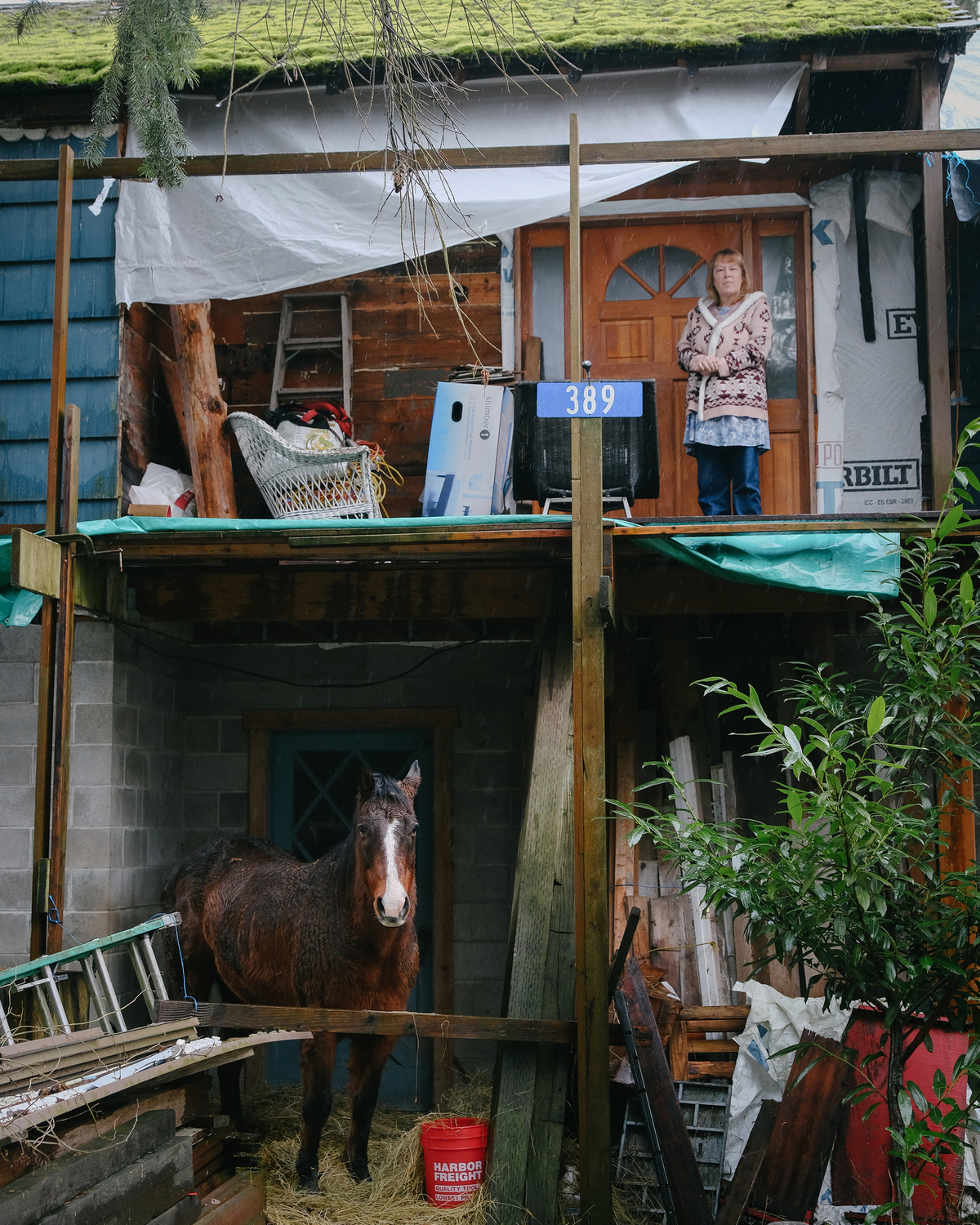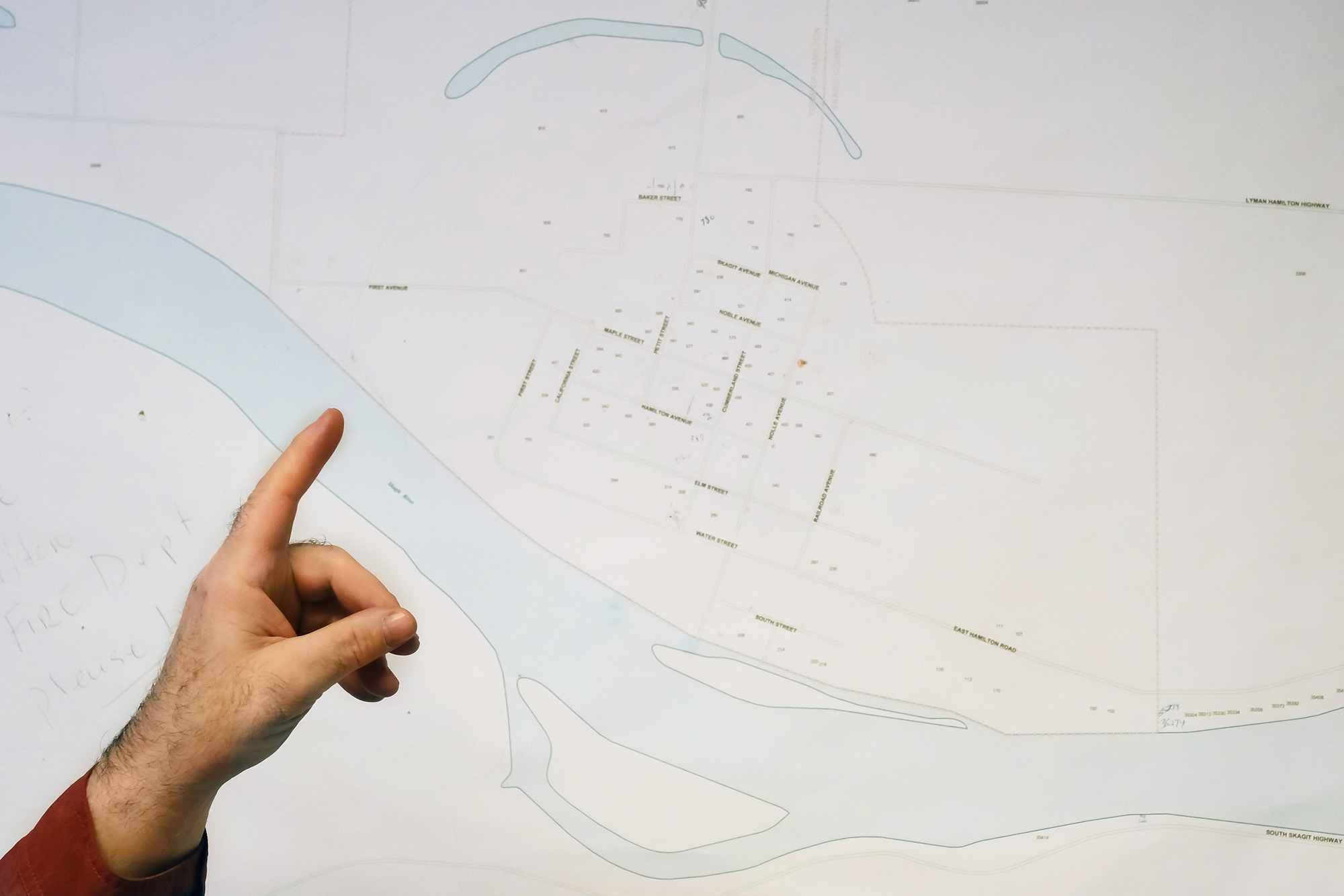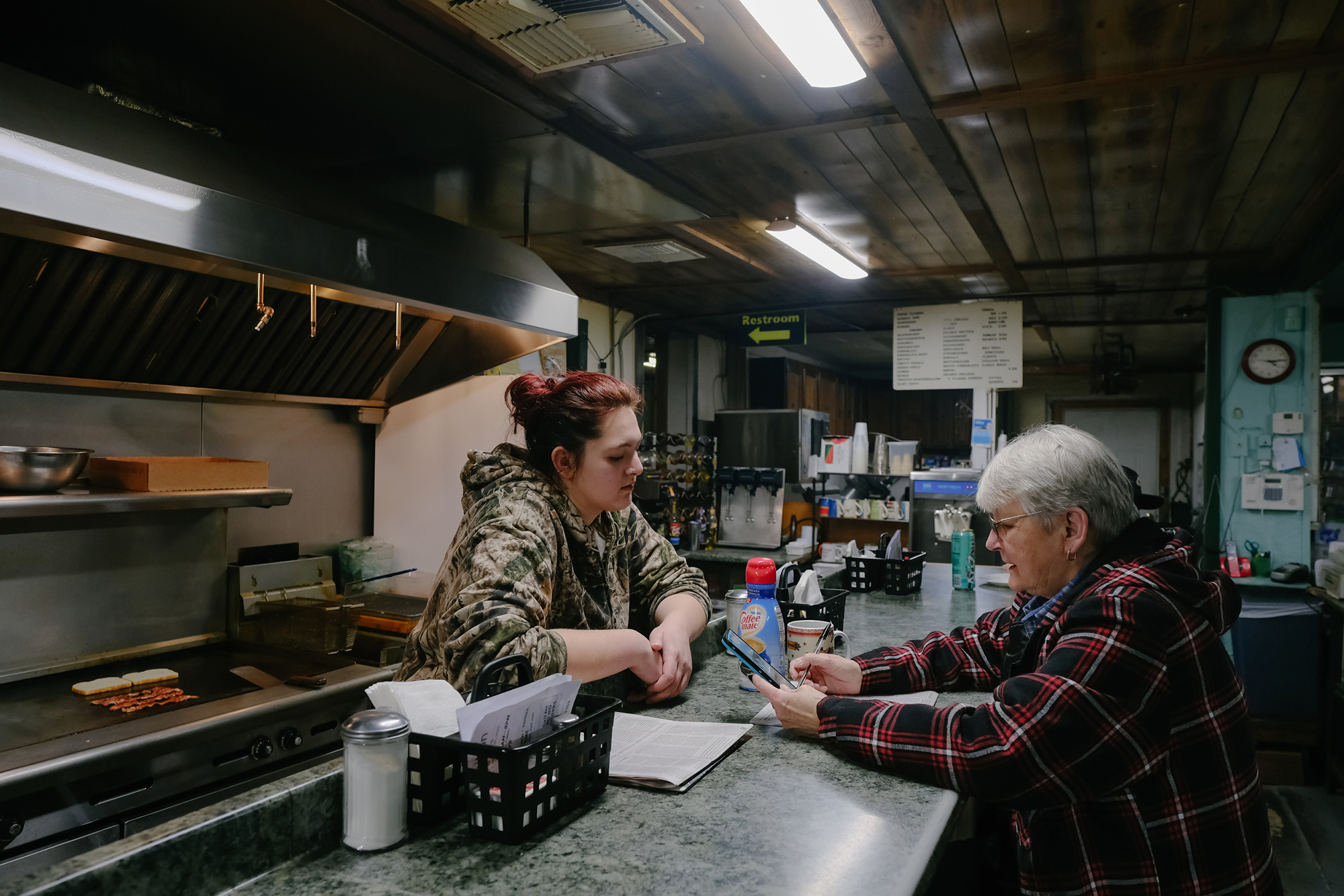
But a monitor perched behind her shows why, in the eyes of some, they should.
Vandiver’s web browser is open to a National Weather Service projection showing how high the Skagit will rise in the coming hours. It’s raining heavily outside, and a flood watch has been issued. So Vandiver watches, though the river won’t jump its banks this time.
But the time will come when the Skagit will again tear through Hamilton, sweeping under homes perched on stilts and through those that remain grounded. The Skagit County town weathers a serious flood every three or four years; nowhere in Washington do property owners draw on flood insurance more often. The National Flood Insurance Program has paid $4 million in claims to Hamilton residents, while $1.4 million in Federal Emergency Management Agency funding has gone toward buyouts and grants in the city.
No one can force out those who call Hamilton home. But the past 40 years have seen a succession of attempts at building a higher, drier Hamilton town site in the timberland and pasture across State Route 20 from where the town has stood since 1877.
Less than a year ago, land conservation organization Forterra drew accolades for buying a 40-acre parcel near Hamilton. The move was celebrated as a first step toward relocating the town to an eco-friendly village. Hamilton’s houses and their septic tanks, it seemed, were finally making way for good sense and spawning salmon: Conservationists argue that habitat restoration on the Hamilton floodplain could boost the dwindling Chinook runs here, though critics counter that would take decades.
Hamilton’s enhanced flood risk is a unique product of geography and atmosphere. A band of moisture in the sky known as an “atmospheric river” forms over the Pacific Ocean. Thousands of miles long and hundreds of miles wide, the bands collide with the Cascades. When that happens, a phenomenal amount of water is forced through the narrow valley in which Hamilton sits. During the last major flood, in 2003, 1.2 million gallons of water flowed through the town each second. Built on the inside edge of a curve in the Skagit River, Hamilton is squarely in the path of least resistance.
State emergency managers and the Union of Concerned Scientists suggest Washington will see extreme storms more often as the climate continues to change. Washington rivers are expected to flood more often in the winter and less often in the spring.
Whether climate change will increase flood intensity on the Skagit River is still something of an unknown, said Mark Mastin, a surface water specialist with the U.S. Geological Survey’s Washington Water Science Center. But all indications are that more rain and less snow will mean more flooding west of the Cascade curtain.
“You would expect more precip during the winter as rain, and that's when we get our floods,” Mastin said.
Forterra hopes to build a collection of owner-occupied homes — complete with community spaces, storefronts and sewers — that can absorb Hamilton’s population while attracting newcomers. Homes sold at market rate would subsidize those bought by Hamilton residents who would otherwise struggle to afford the move.
For now, all that is little more than a dream — and it’s one not widely shared in Hamilton.
“My sense is that most people [in Hamilton] are either skeptical about it or opposed to it,” Michelle Connor, president and CEO of Forterra, told Crosscut in an interview in January.
“We believe we can build something that is beautiful and affordable,” Connor continued. “And if not this generation, maybe their kids will come over.”
Stay or go?
For two years, Geoff Perkins has lived in a home untouched by flooding in its 112 years of existence. The threshold of his front door is an inch below the height of a 100-year flood for this location. He loves the stained glass windows, antique radiators and views.
“I see mountains out of every window in the house,” Perkins said.
“Everyone talks about Hamilton, ‘all these people who are stuck, these poor people,’ ” he continued. “Most of the people are here because they like the spot.”
Relocation plans first arose when a flood in 1979 prompted FEMA to float a buyout proposal. When the Skagit jumped its banks again the next year, FEMA returned with the Army Corps of Engineers. They found few takers.
“The town didn't want relocation,” said Chuck Steele, a retired flood mitigation expert whose career included a 20-year stint with FEMA and 12 years with the state Department of Ecology flood program.
“There are just a lot of people that just don't want to leave Hamilton,” Steele said. “They enjoy the place. If you've ever been there, it's kind of hard to understand why. It's not a real pleasant community.”
Stagnation has settled on Hamilton. The town’s population is shrinking year by year. Nothing can be built in the floodplain, and buildings damaged by flood, fire, storm or accident can’t be repaired. Residents still love it.
Vandiver fell for Hamilton while fixing up a friend’s home after a flood in the fall of 2017. She bought that house two years ago, settled in and now leads a cash-strapped town struggling to provide basic services.
“Things have just been let go to hell,” Vandiver said. “Looking at this town, you can tell the level of mess.”
Blackberry vines swallow lots and fences. Water ponds on asphalt streets, some of which Vandiver says are crumbling because of burst pipes. The town park and its gazebo are in disrepair, its bathrooms flooded and left to mold.
Since the first buyouts after the 1979 and 1980 floods, 22 properties have been purchased and cleared. Those that haven’t been reoccupied by RVs are covered with blackberries or tightly mowed grass.
About 2½ years ago, Forterra's Connor took a call from Hamilton’s previous mayor, Joan Cromley. Cromley had learned that the owner of a 40-acre parcel that could serve as a new town center was ready to sell. Cromley wondered if Forterra might fund the purchase.
Connor realized Forterra could, using a bequest earmarked specifically for habitat restoration. In drawing on donated money rather than a loan, Forterra addressed concerns of tribal leaders in the area who worried Forterra might sell the land to a for-profit developer if the project stalled before the loan came due.
Recent history, too, argued for a more patient approach.
A decade after the 1980 relocation push, U.S. Rep. Al Swift worked with residents to buy timberland across the highway with the aim of building a new town there. That effort fell apart. “This logging company wanted the federal government to do all the work,” recalled Steele, the retired flood mitigation expert. Another attempt prompted by the November 2003 flood failed as well.
“There was not enough money to pay for it,” Steele said. “And there was opposition.”
Any illusions of community enthusiasm Forterra held were dashed in November, when Cromley was unseated by Vandiver, who said concerns about the Forterra project drove the election. Vandiver won with 49 votes to Cromley’s 37. Residents, she said, don’t believe Forterra has been straight with them.
Retrieving a plastic folder from a repurposed dining room where the town council meets once a month, Vandiver thumbed through photos of new, minimalist Nordic buildings circulated by Forterra last year to give residents a glimpse of what might be.
The million-dollar homes, with their industrial white counters and high-angle, farm-red roofs, were unbelievable, Vandiver said.
“These are not for laborers and retired people and old people, you know?” said Vandiver as she passed across a photo capturing the view from an airy dining room in New Zealand. “This is Seattle. Bellevue. Mercer Island. That’s not going to fly out here."

At Forterra, Connor said “consternation” at the rebuke eventually gave way to a recognition that Hamilton residents would decide their community’s future.
“The project as loosely envisioned is in a very immature state, so we haven't given the community a lot to work with,” Connor said. “I think we owe them more information, and we owe them more engagement [about] what could be there. And we owe them a choice.”
Tribal allies
Forterra hopes habitat restoration projects can follow as individual homeowners move on, Connor said. That work, she said, will proceed in collaboration with residents and the three nearby tribal governments, which have led revival work on the Skagit for decades.
“When settlers came to Fir Island at the mouth of the Skagit River, they asked where to build their houses,” Swinomish Chairman Brian Cladoosby said in April, when the project was announced. “Our elders said, ‘Do you see those mud marks up on the trees? Build above there.’ Unfortunately, recent settlers did not hear that advice and built right next to the river in harm’s way. Beginning this important effort to move people out of the floodplain and reconnect our salmon with the habitats that are so critical to their existence.”
While habitat restoration work has proceeded on the floodplain west of Hamilton, the town sits on one of the largest pieces of recoverable floodplain below the dam on the Baker River, which enters the Skagit about 12 miles upstream from Hamilton.
Scott Schuyler, natural resources director of the Upper Skagit Tribe, described the Forterra project as a “potential win-win” for Hamilton residents and Skagit River salmon, which has seen its six wild chinook salmon populations decline dramatically. The loss of the floodplain’s nursery habitat, where adult salmon lay their eggs and juvenile salmon mature, is a key factor in that decline. Schuyler notes that the river’s summer-fall chinook run spawns in the area near Hamilton.
Schuyler, an elder with the Sedro-Woolley-based tribe, said the salmon remain “in dire need of help at this time.” To protect stocks, tribal commercial fishermen in recent years have curtailed wild chinook harvests guaranteed to the tribes by treaty, Schuyler said.
“It’s vital to recover salmon from our perspective because the sacred Skagit River is the heart of the tribe,” he continued. “Not only do we rely on the Skagit to sustain our fishing culture and give our treaty rights meaning, but so much is affected by low salmon populations,” including the Puget Sound resident orca.
Connor said Forterra will follow the landowners' and tribes' lead when restoration work begins in Hamilton.
“The community and the landowners and the tribes are going to be the ones that know what's in their best interest on the land,” Connor said. “It would be completely presumptuous for us to step into that space.”
Economics of relocation
An average Hamilton house is valued at about $120,000, and most recent property sales inside the city limits have been for five-figure sums. But for the people who live in them, their worth is far higher than their market valuation.
Any new construction could easily sell for two or three times the price government buyers would offer for a Hamilton house, if said buyouts could be arranged. There exists, Connor said, “a gigantic gap” between prices set by the market and the costs many Hamilton residents can cover.
Details of financing have yet to be worked out, Connor said. Profits from new homes sold at market rates would likely subsidize new housing for Hamilton residents, as would grants or gifts that could be secured. Connor said Forterra is committed to ensuring that any Hamilton resident interested in selling and moving uphill can do so.
In Vandiver’s view, the big benefit of Forterra’s development will be an infusion of tax revenue to town coffers. The current $300,000-or-so annual budget doesn’t go far.
“They can build their houses over there and sell them to whomever they want as long as we get our cut,” Vandiver said. “And then I want to see the town fixed back up.”
Perkins, who joined the town council in September 2018, sees the Forterra development as a way to grow Hamilton’s tax base and fund city services. Code enforcement is a particular challenge for the town; derelict cars fill front yards and broken buildings are left to rot.
As for Forterra’s relocation aims, Perkins disputes the use of the term.
“It’s not a relocation. Nobody is getting bought out. Nobody is moving. Not a single building is actually being moved,” he said. “It’s merely an expansion of the town limits. There is no relocation of any kind.”
Connor remains hopeful that residents will warm to the idea as the planning rolls forward. Forterra expects to release a master plan later this year that will give residents a better idea of what their potential new homes could look like. She has faith in the Field of Dreams theory of construction: “If we build it,” she said, “we believe they will come.”

The river has not yet had its say. No one living has seen the worst flooding the Skagit can deliver. River records from the 1800s and early 1900s describe water volumes half again as large as any that have occurred in the 70 years since two large hydroelectric dams in the North Cascades harnessed the Skagit. Vandiver and Perkins, like more than 70% of the people residing in Hamilton, did not live there the last time a major flood swept through town.
Mastin, the USGS water scientist, took a hard look at those old river records a few years ago. He expected to find a flaw that would explain the fantastically high flow rates. He didn’t.
“We concluded that the data was pretty good and there were some very large floods back then,” said Mastin, who has been studying flooding in Washington for 35 years.
“There's a lot of potential for some big floods on the Skagit,” he continued. “Hopefully the dams will dampen that somewhat, but I don't think the dams could hold back that much water. We’d still have pretty catastrophic results.
“Since they've happened in the past, we have to think it can happen again.”







